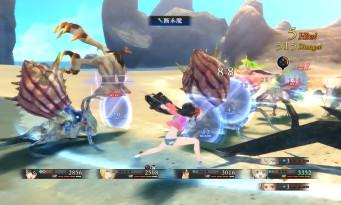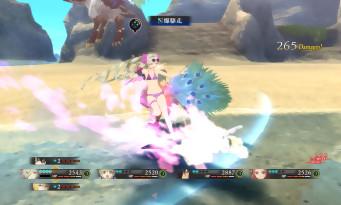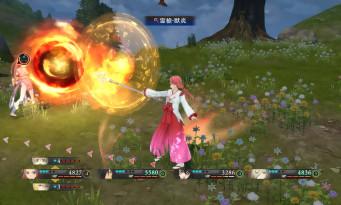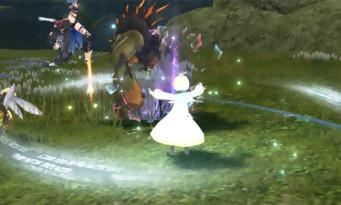 And if we put the two protagonists in parallel, it's not only because the games that feature them follow each other: Tales of Berseria takes place in the same world as Tales of Zestiria, but a millennium earlier . We therefore follow Velvet, a young girl with thick hair, who lost her big sister during the opening of the Demonic Breach, when she and her younger brother Laphicet were only toddlers. Since this event, they have lived alongside their brother-in-law and mentor, Artorius, all three reclusive in their village while the plague that turns humans into demons continues to eat away at the world outside. A relative peace that will only last a few years, until the enigmatic Artorius reveals a completely different face and chooses to sacrifice the young Laphicet to gain the power to repel the scourge. Torn by pain, Velvet will reveal her partially demonic nature, through this monstrous left arm capable of absorbing magical beings, and find herself imprisoned for three years. A period that she will use to forge an unfailing will for revenge.
And if we put the two protagonists in parallel, it's not only because the games that feature them follow each other: Tales of Berseria takes place in the same world as Tales of Zestiria, but a millennium earlier . We therefore follow Velvet, a young girl with thick hair, who lost her big sister during the opening of the Demonic Breach, when she and her younger brother Laphicet were only toddlers. Since this event, they have lived alongside their brother-in-law and mentor, Artorius, all three reclusive in their village while the plague that turns humans into demons continues to eat away at the world outside. A relative peace that will only last a few years, until the enigmatic Artorius reveals a completely different face and chooses to sacrifice the young Laphicet to gain the power to repel the scourge. Torn by pain, Velvet will reveal her partially demonic nature, through this monstrous left arm capable of absorbing magical beings, and find herself imprisoned for three years. A period that she will use to forge an unfailing will for revenge.
AN IRON HAND IN A VELVET GLOVE
 If Tales of Berseria can be considered slightly better than Xillia or Zestiria, it is therefore primarily thanks to its heroine with undeniable charisma. If her plastic should still make people cringe, the young demon woman surprises by her darkness, by her determination to accomplish her revenge whatever the cost. Hardened by her years in prison but above all devoured by her evil nature which gradually erases her human feelings, she goes through the adventure without worrying about the damage she may cause in her wake. No matter if she has to commit murder, if she has to use people as mere tools, if she has to betray the trust of others or hurt the unfortunate people who choose to follow her, Velvet is blinded by her thirst for revenge and it must be admitted that this gives it a particularly appreciable thickness. Especially when you know the lack of charisma of the last heroes of the saga (one of them was also sadly silent). And we must admit that it is she who tows a cast with a typology that is ultimately quite classic for a J-RPG. Tales of Berseria also takes up the system of animated manga-style sketches to make all this little world interact, by fleshing out the scenario or simply by lightening the rather heavy atmosphere.
If Tales of Berseria can be considered slightly better than Xillia or Zestiria, it is therefore primarily thanks to its heroine with undeniable charisma. If her plastic should still make people cringe, the young demon woman surprises by her darkness, by her determination to accomplish her revenge whatever the cost. Hardened by her years in prison but above all devoured by her evil nature which gradually erases her human feelings, she goes through the adventure without worrying about the damage she may cause in her wake. No matter if she has to commit murder, if she has to use people as mere tools, if she has to betray the trust of others or hurt the unfortunate people who choose to follow her, Velvet is blinded by her thirst for revenge and it must be admitted that this gives it a particularly appreciable thickness. Especially when you know the lack of charisma of the last heroes of the saga (one of them was also sadly silent). And we must admit that it is she who tows a cast with a typology that is ultimately quite classic for a J-RPG. Tales of Berseria also takes up the system of animated manga-style sketches to make all this little world interact, by fleshing out the scenario or simply by lightening the rather heavy atmosphere.
CRUISING SPEED
 This new episode will not upset your habits either in terms of rhythm or structure, since it is divided between exploration phases, dungeons and major fights. Difficult to speak of main quest or side quests elsewhere insofar as Berseria remains very interventionist. The extras will take more the form of additional activities, such as hunting Code Red demons, cooking, opening minouz chests or even exploring the world through the management of reconnaissance missions. Each time, these are only facilitators of the main quest or more simply missions that will offer you cosmetic items. We are far from being faced with a huge amount of work to integrate these secondary activities into the plot, but at least they have the merit of not encroaching on the main quest in too awkward a way, and they can be avoided if they seem to you unpleasant. The main quest, on the other hand, suffers each time it switches to daunting phases of exploration, whether outdoors or in excessively sad labyrinths. The only interest then lies in collecting objects for crafting or to buy equipment.
This new episode will not upset your habits either in terms of rhythm or structure, since it is divided between exploration phases, dungeons and major fights. Difficult to speak of main quest or side quests elsewhere insofar as Berseria remains very interventionist. The extras will take more the form of additional activities, such as hunting Code Red demons, cooking, opening minouz chests or even exploring the world through the management of reconnaissance missions. Each time, these are only facilitators of the main quest or more simply missions that will offer you cosmetic items. We are far from being faced with a huge amount of work to integrate these secondary activities into the plot, but at least they have the merit of not encroaching on the main quest in too awkward a way, and they can be avoided if they seem to you unpleasant. The main quest, on the other hand, suffers each time it switches to daunting phases of exploration, whether outdoors or in excessively sad labyrinths. The only interest then lies in collecting objects for crafting or to buy equipment. Once again, the series stands out for the general poverty of its sets, which are sorely lacking in life and detail.
 Like its elders, Tales of Berseria again lags behind technically, which tends to be reduced, but which remains considerable. The fault of the versions developed on both PS3 and PS4 for a question of sales targets. The character models and animations therefore gain a little finesse in this new opus. Aliasing is much less noticeable than before, loading times have faded and the framerate has stopped sputtering. But it's the least of the things you can hope for when you see the general rendering of the game. Once again, the series stands out for the general poverty of its decorations, which are sorely lacking in life and detail (d as much as once again, the clipping is there, very present, to break the immersion); an even more obvious observation in the dungeons which, in addition to being sad, are really visually repetitive. If we add to this the very uninspired design of certain enemies, we end up concluding that Berseria is still a disappointment for the retina. At least for a 2017 game!
Like its elders, Tales of Berseria again lags behind technically, which tends to be reduced, but which remains considerable. The fault of the versions developed on both PS3 and PS4 for a question of sales targets. The character models and animations therefore gain a little finesse in this new opus. Aliasing is much less noticeable than before, loading times have faded and the framerate has stopped sputtering. But it's the least of the things you can hope for when you see the general rendering of the game. Once again, the series stands out for the general poverty of its decorations, which are sorely lacking in life and detail (d as much as once again, the clipping is there, very present, to break the immersion); an even more obvious observation in the dungeons which, in addition to being sad, are really visually repetitive. If we add to this the very uninspired design of certain enemies, we end up concluding that Berseria is still a disappointment for the retina. At least for a 2017 game!SENSITIVE SOULS REFRAIN
 This is where once again Bandai Namco's know-how in terms of combat systems comes to save the day. Of course, as usual, you have to swallow a lot of information in just a few hours at the start of the adventure. And the result is difficult to read once the confrontation has started. But it must be recognized that the whole benefits from an enormous depth and a sacred margin of progression. The possible mana gauge is here replaced by a system of Souls to be spent and recovered during the fight following his actions. Exploiting an enemy's weaknesses, stunning them, or even eliminating them from the battlefield can increase your Soul gauge and you can therefore chain more Artes, which more or less empty this gauge depending on their power. However, be careful not to uncover yourself, because once the gauge is empty, you will be vulnerable. On the other hand, Velvet has the possibility of transforming into a demon, then using her life and no longer her energy to lacerate her enemies. It thus fills a power gauge which will be used for a Mystical Arte in the form of a supreme blow, or for a switch between the characters in order to lengthen the current combo. And all this is only part of a system that is once again very hairy and hard to master, which includes the customization of teammates.
This is where once again Bandai Namco's know-how in terms of combat systems comes to save the day. Of course, as usual, you have to swallow a lot of information in just a few hours at the start of the adventure. And the result is difficult to read once the confrontation has started. But it must be recognized that the whole benefits from an enormous depth and a sacred margin of progression. The possible mana gauge is here replaced by a system of Souls to be spent and recovered during the fight following his actions. Exploiting an enemy's weaknesses, stunning them, or even eliminating them from the battlefield can increase your Soul gauge and you can therefore chain more Artes, which more or less empty this gauge depending on their power. However, be careful not to uncover yourself, because once the gauge is empty, you will be vulnerable. On the other hand, Velvet has the possibility of transforming into a demon, then using her life and no longer her energy to lacerate her enemies. It thus fills a power gauge which will be used for a Mystical Arte in the form of a supreme blow, or for a switch between the characters in order to lengthen the current combo. And all this is only part of a system that is once again very hairy and hard to master, which includes the customization of teammates.
























